Book Review: Miss Leavitt’s Stars
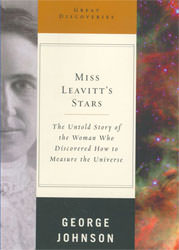
Miss Henrietta Swan Leavitt obtained work at Harvard Observatory to review photographic plates. These were coming in fast and furious from the many large observatories being built in the Americas. These plates recorded the moment, but humans needed to interpret the dots. Small differences may be due to atmospheric effects, telescope adjustments, emulsion reactions or human intervention. Yet interpreting dots was considered an unworthy task for men, so women like Miss Leavitt were paid about minimum wage to spend hours every day looking at these plates, comparing each against another and against various metrics. With their effort, characteristics were catalogued for tens of thousands of stars.
The biography of a human computer sounds dry without even cracking open a book’s cover. Their task would simply be onerous repetition of the mundane. However, Johnson puts little time describing this aspect of Leavitt’s life. Actually, as Johnson acknowledges, there’s precious little remaining that describes Leavitt at all. Almost no first hand records exist. Most documents are second hand in nature and regard her circumstances from a very business like view. For example, either the observatory director or another astronomer would write discussing Leavitt’s work, her results and interest for future work. Johnson even had to dig into census data to discover where she lived and with whom. With such a dearth of information, Johnson has had to expand upon writing a biography so he adds a good look at the venture directly related to Leavitt’s work, the estimation of the size of the universe.
As such, Johnson smoothly takes the reader on a journey through parallax measurements, red-blue shifting, luminosity, galaxies and variables. Certainly there’s Leavitt’s discovery published in 1908 where she noted that brighter variables have longer periods. This observation came in a publication that gave a full account of 1777 variables in the Magellanic Cloud, and was so entitled. We also read of Shapely’s and Curtis’s debate in 1920 on whether the Milky Way was the universe or whether the Milky Way was just one typical galaxy amongst others. Eventually Edwin Hubble used Leavitt’s relationship of Cepheid variables to show that Barnard’s Galaxy was over 700 000 light years away and certainly outside the realm of the Milky Way. Johnson then ends the book with a discussion of Hubble’s constant that relates a galaxy’s velocity to its distance.
As one can tell, this book is much more than just about Leavitt. There’s some mention of her childhood, her accommodations and relatives. There’s also some information about her vacation travels, her frequent time off for convalescence and the on-set of her deafness. Johnson does add nice touches about society at the time, such as Leavitt completing the requirements for a Bachelor of Arts degree, but because she wasn’t male, she could only get a certificate. He also notes the better known information, such as her epic in 1914 on the North Polar Sequence, which at 84 pages defined 96 stars for use as a standard for all astronomers. But as most of this could have been done in a small number of pages, Johnson ably and expansively enlarges this biography to include the topic that so dominated Leavitt’s work.
Therefore, though the title may be a bit misleading, this book does an admirable job at presenting Leavitt’s life and especially her life’s interest. As well, Johnson wrote all astronomical details from a generalist’s point of view which can easily be understood by anyone without training. Corollaries are common and clear. The occasional wandering in the subject adds to the reading rather than distracts the reader. The few pictures help visualize the main characters, while the adherence to the subject keeps the book tight and informative.
Computers will do what they’re told. But they can’t step back and deduce patterns nor generalize. Humans excel at this function and George Johnson in his book, Miss Leavitt’s Stars, presents the benefit all astronomers owe to Miss Henrietta Swan Leavitt, the human computer who first came to understand the relationship between the periodicity of Cepheid variables and their distance. His book shows she was a special person who admirably worked above the call of duty to augment our knowledge one step further.
Review by Mark Mortimer
Read more reviews online, or purchase a copy from Amazon.com.
Saturn’s Graceful Crescent
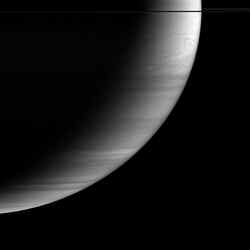
Saturn’s crescent. Image credit: NASA/JPL/SSI Click to enlarge
Feathery cloud bands fill Saturn’s graceful crescent. Features in the atmosphere are visible all the way to the terminator, the boundary between night and day, where the Sun’s rays are coming in almost horizontally.
Because it is possible to see down to the same level, regardless of how high the Sun is above the horizon, this indicates that the atmosphere above the clouds is relatively clear.
The dark line across the top of the image is the nearly edge-on ringplane.
The image was taken in infrared light (centered at 728 nanometers) with the Cassini spacecraft wide-angle camera on Oct. 31, 2005, at a distance of approximately 1.2 million kilometers (800,000 miles) from Saturn and at a Sun-Saturn-spacecraft, or phase, angle of 131 degrees. Image scale is 69 kilometers (43 miles) per pixel. The image was contrast enhanced to improve visibility of features in the atmosphere.
The Cassini-Huygens mission is a cooperative project of NASA, the European Space Agency and the Italian Space Agency. The Jet Propulsion Laboratory, a division of the California Institute of Technology in Pasadena, manages the mission for NASA’s Science Mission Directorate, Washington, D.C. The Cassini orbiter and its two onboard cameras were designed, developed and assembled at JPL. The imaging operations center is based at the Space Science Institute in Boulder, Colo.
For more information about the Cassini-Huygens mission visit http://saturn.jpl.nasa.gov . The Cassini imaging team homepage is at http://ciclops.org .
Original Source: NASA/JPL/SSI News Release
Dust Storms on the Moon
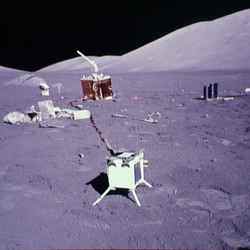
The Lunar Ejecta and Meteorites Experiment (LEAM). Image credit: NASA Click to enlarge
Every lunar morning, when the sun first peeks over the dusty soil of the moon after two weeks of frigid lunar night, a strange storm stirs the surface.
The next time you see the moon, trace your finger along the terminator, the dividing line between lunar night and day. That’s where the storm is. It’s a long and skinny dust storm, stretching all the way from the north pole to the south pole, swirling across the surface, following the terminator as sunrise ceaselessly sweeps around the moon.
see captionNever heard of it? Few have. But scientists are increasingly confident that the storm is real.
The evidence comes from an old Apollo experiment called LEAM, short for Lunar Ejecta and Meteorites. “Apollo 17 astronauts installed LEAM on the moon in 1972,” explains Timothy Stubbs of the Solar System Exploration Division at NASA’s Goddard Space Flight Center. “It was designed to look for dust kicked up by small meteoroids hitting the moon’s surface.”
Billions of years ago, meteoroids hit the moon almost constantly, pulverizing rocks and coating the moon’s surface with their dusty debris. Indeed, this is the reason why the moon is so dusty. Today these impacts happen less often, but they still happen.
Apollo-era scientists wanted to know, how much dust is ejected by daily impacts? And what are the properties of that dust? LEAM was to answer these questions using three sensors that could record the speed, energy, and direction of tiny particles: one each pointing up, east, and west.
LEAM’s three-decade-old data are so intriguing, they’re now being reexamined by several independent groups of NASA and university scientists. Gary Olhoeft, professor of geophysics at the Colorado School of Mines in Golden, is one of them:
“To everyone’s surprise,” says Olhoeft, “LEAM saw a large number of particles every morning, mostly coming from the east or west–rather than above or below–and mostly slower than speeds expected for lunar ejecta.”
What could cause this? Stubbs has an idea: “The dayside of the moon is positively charged; the nightside is negatively charged.” At the interface between night and day, he explains, “electrostatically charged dust would be pushed across the terminator sideways,” by horizontal electric fields. (Learn more: “Moon Fountains.” )
Even more surprising, Olhoeft continues, a few hours after every lunar sunrise, the experiment’s temperature rocketed so high–near that of boiling water–that “LEAM had to be turned off because it was overheating.”
Those strange observations could mean that “electrically-charged moondust was sticking to LEAM, darkening its surface so the experiment package absorbed rather than reflected sunlight,” speculates Olhoeft.
But nobody knows for sure. LEAM operated for a very short time: only 620 hours of data were gathered during the icy lunar night and a mere 150 hours of data from the blazing lunar day before its sensors were turned off and the Apollo program ended.
Astronauts may have seen the storms, too. While orbiting the Moon, the crews of Apollo 8, 10, 12, and 17 sketched “bands” or “twilight rays” where sunlight was apparently filtering through dust above the moon’s surface. This happened before each lunar sunrise and just after each lunar sunset. NASA’s Surveyor spacecraft also photographed twilight “horizon glows,” much like what the astronauts saw.
It’s even possible that these storms have been spotted from Earth: For centuries, there have been reports of strange glowing lights on the moon, known as “lunar transient phenomena” or LTPs. Some LTPs have been observed as momentary flashes–now generally accepted to be visible evidence of meteoroids impacting the lunar surface. But others have appeared as amorphous reddish or whitish glows or even as dusky hazy regions that change shape or disappear over seconds or minutes. Early explanations, never satisfactory, ranged from volcanic gases to observers’ overactive imaginations (including visiting extraterrestrials).
Now a new scientific explanation is gaining traction. “It may be that LTPs are caused by sunlight reflecting off rising plumes of electrostatically lofted lunar dust,” Olhoeft suggests.
All this matters to NASA because, by 2018 or so, astronauts are returning to the Moon. Unlike Apollo astronauts, who never experienced lunar sunrise, the next explorers are going to establish a permanent outpost. They’ll be there in the morning when the storm sweeps by.
The wall of dust, if it exists, might be diaphanous, invisible, harmless. Or it could be a real problem, clogging spacesuits, coating surfaces and causing hardware to overheat.
Which will it be? Says Stubbs, “we’ve still got a lot to learn about the Moon.”
Original Source: NASA News Release
Smaller Ozone Hole This Year

The ozone hole: 2005. Image credit: NASA. Click to enlarge
NASA researchers, using data from the agency’s AURA satellite, determined the seasonal ozone hole that developed over Antarctica this year is smaller than in previous years.
NASA’s 2005 assessment of the size and thickness of the ozone layer was the first based on observations from the Ozone Monitoring Instrument on the agency’s Aura spacecraft. Aura was launched in 2004.
This year’s ozone hole measured 9.4 million square miles at its peak between September and mid-October, which was slightly larger than last year’s peak. The size of the ozone hole in 1998, the largest ever recorded, averaged 10.1 million square miles. For 10 of the past 12 years, the Antarctic ozone hole has been larger than 7.7 million square miles. Before 1985, it measured less than 4 million square miles.
The protective ozone layer over Antarctica annually undergoes a seasonal change, but since the first satellite measurements in 1979, the ozone hole has gotten larger. Human-produced chlorine and bromine chemicals can lead to the destruction of ozone in the stratosphere. By international agreement, these damaging chemicals were banned in 1995, and their levels in the atmosphere are decreasing.
Another important factor in how much ozone is destroyed each year is the temperature of the air high in the atmosphere. As with temperatures on the ground, some years are colder than others. When it’s colder in the stratosphere, more ozone is destroyed. The 2005 ozone hole was approximately 386,000 square miles larger than it would have been in a year with normal temperatures, because it was colder than average. Only twice in the last decade has the ozone hole shrunk to the size it typically was in the late 1980s. Those years, 2002 and 2004, were the warmest of the period.
Scientists also monitor how much ozone there is in the atmosphere from the ground to space. The thickness of the Antarctic ozone layer was the third highest of the last decade, as measured by the lowest reading recorded during the year. The level was 102 Dobson Units (the system of measurement designated to gauge ozone thickness). That is approximately one-half as thick as the layer before 1980 during the same time of year.
The Ozone Monitoring Instrument is the latest in a series of ozone-observing instruments flown by NASA over the last two decades. This instrument provides a more detailed view of ozone and is also able to monitor chemicals involved in ozone destruction. The instrument is a contribution to the mission from the Netherlands’ Agency for Aerospace Programs in collaboration with the Finnish Meteorological Institute. The Royal Netherlands Meteorological Institute is the principal investigator on the instrument.
For more information on NASA’s Aura mission on the Web, visit:
http://www.nasa.gov/aura
Original Source: NASA News Release
New Views of Saturn’s Moons
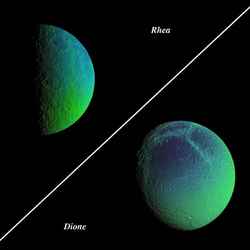
False-color views of Saturn’s cratered, icy moons, Rhea and Dione. Image credit: NASA/JPL/SSI Click to enlarge
Wrapping up a phenomenally successful year of observing Saturn’s icy moons, the Cassini mission is releasing a flood of new views of the moons Enceladus, Dione, Rhea, Hyperion and Iapetus.
The moons and their intricacies are being highlighted at a news briefing today at the American Geophysical Union meeting in San Francisco.
Several new images of Rhea, a moon measuring 1,528 kilometers (949 miles) across, were taken during Cassini’s most recent close flyby on November 26. During the encounter, Cassini dipped to within 500 kilometers (310 miles) of Rhea’s surface.
Additional new images include two “zoomable” mosaics of Rhea and Hyperion at high resolution; false-color views revealing compositional variation on the surfaces of Hyperion, Dione and Rhea; two movies reproducing Cassini’s exciting encounters with Iapetus and Hyperion; and dazzling new images of the plumes of Enceladus, including a time-lapse movie.
The Cassini-Huygens mission is a cooperative project of NASA, the European Space Agency and the Italian Space Agency. The Jet Propulsion Laboratory, a division of the California Institute of Technology in Pasadena, manages the Cassini-Huygens mission for NASA’s Science Mission Directorate, Washington. The Cassini orbiter and its two onboard cameras were designed, developed and assembled at JPL. The imaging team is based at the Space Science Institute, Boulder, Colo.
The image products being released include large mosaics, movies and false-color views. They are available at: http://saturn.jpl.nasa.gov , http://www.nasa.gov/cassini and http://ciclops.org .
Original Source: NASA News Release
Hubble’s Detailed Look at Stellar Jets
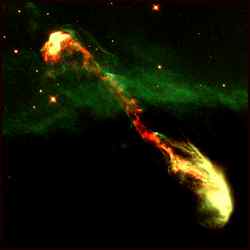
Stellar jets. Image credit: Hubble. Click to enlarge
Like traffic on a freeway, plasma spewing from the poles of newborn stars moves in clumps that travel at different speeds. When fast-moving particles run into slower material on these cosmic freeways, the resulting “traffic jams” create massive shock waves that travel trillions of miles.
Thanks to highly resolved images from the Hubble Space Telescope, a team of astronomers have created the first moving pictures of one of these cosmic freeways, which are known as stellar jets. The movies allow scientists to trace these stellar jet shock waves for the first time, gleaning important clues about a critical, yet poorly understood process of starbirth. The results appeared in the November issue of Astronomical Journal.
“When it comes to actually showing exactly what’s going on, there’s just nothing like a movie,” said study co-author Patrick Hartigan, associate professor of physics and astronomy at Rice University. “You can look at a still image and make up all kinds of stories, but they all go out the window when you see a movie.”
Hartigan and researchers from the Cerro Tololo Inter-American Observatory (CTIAO) in Chile, Arizona State University (ASU), the University of Hawaii and the University of Colorado at Boulder, made the movies using images taken in 1994 and 1999 of a newly formed star called HH 47 in the constellation Vela. Because Hubble flies above the Earth’s atmosphere, it can take much clearer images than Earth-based telescopes. As a result, Hartigan and his co-researchers were able to resolve objects in the Hubble images that were 20 times smaller than objects resolved in similar images taken on Earth. This extra resolution, and the five-year gap between Hubble surveys of HH 47, allowed them to make moving pictures of the stellar jet shock waves moving away from the new star.
“Imagine taking a photo at a football game that shows the quarterback throwing the ball at the start of a play,” Hartigan said. “There is no way to know what happened in the play without a second photograph at the end of the play that shows a touchdown, incomplete pass, interception, or whatever occurs. If you take a series of photos, with enough resolution to make out the ball, you could determine whether someone ran with the ball or caught a pass, and you could determine the relative position of all of the players to one another at any time during the play.
“Like the time-lapse images of the game, our movies give us the ability to track the movement of individual features within the stellar jet, both relative to stationary objects and relative to other objects that are moving within the jet at a different speed,” Hartigan said.
New stars form out of giant clouds of gas and dust. Within these clouds, strong gravitational forces pull material together into a tight ball surrounded by a large spinning disk. The new star forms out of the ball, and any planets that might form do so in the disk. Through processes not well-understood, much of the disk material gradually spirals into the star, and the resulting energy from this process drives stellar jets of plasma that erupt from the star at perpendicular angles to the spinning accretion disk. The material thrown away from the star in the jets acts as a brake on disk, slowing its rotation and allowing more material to fall into the growing star. Scientists know stellar jets play an integral role in star formation, but they have yet to determine the specifics of their role, or how it is carried out.
The research was funded by NASA. Co-authors on the study include CTIO’s Steve Heathcote, ASU’s Jon A. Morse, University of Hawaii’s Bo Reipurth and University of Colorado at Boulder’s John Bally.
Original Source: Rice University
Zeiss Optics in Hubble’s Successor
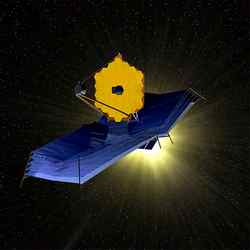
James Webb Space Telescope (JWST). Image credit: NASA Click to enlarge
Carl Zeiss Optronics, in Oberkochen, Germany, and the Max Planck Institute for Astronomy in Heidelberg (MPIA), are developing the main fine mechanical optical technology for two instruments to be part of the James Webb Space Telescope (JWST). Over the next eight years, under administration of the European Space Agency and NASA in the USA, the JWST (with a mirror of 6.5 metres) will shape up to be the successor to the legendary HUBBLE Space Telescope. Carl Zeiss and the Max Planck Institute signed a contract on November 29 to co-operate in their work on the MIRI and NIRSpec instrumentation of the JWST.
The JAMES WEBB Space Telescope is going to replace the Hubble Space Telescope in the next few decades as the most important tool for astronomical observation. The most important scientific goal of the mission is to discover the “first light” of the early universe – the formation of the first stars out of the slowly cooling Big Bang. The light from these first stars and galaxies has shifted into the infrared spectrum because its wavelength has stretched out some twenty times, as the universe has been expanding. The infrared (warm) radiation of the telescope and its instruments could disturb these weak cosmic signals. In order to prevent this, the telescope has to be essentially deep frozen.
For this reason, the JWST will be stationed at the “Lagrangian point L2”, 1.5 million kilometres outside the Earth?s orbit. The gravitational forces of the Sun and the Earth balance each other at L2, so the JWST can maintain a position synchronous with the sun and the Earth, permanently on the far side of the Earth from the sun. Here, the telescope and its instruments will cool down to -230 degrees Celsius. The extremely high sensitivity and resolution of the huge telescope will lead to entirely new insights about the formation of stars and planets in the Milky Way Galaxy. These investigations are only possible in the infrared spectrum. Unlike visible light, infrared light can pass through the thick gas and dust clouds, in which planets and stars form, without being appreciably weakened.
The telescope and its instruments make immense demands. They will be subject to initial stress at an acceleration much higher than the Earth?s, and then cooled down to a temperature almost reaching absolute zero (-273 degrees Celsius). After the telescope is put into operation at its final location, its astronomical instruments will be adjusted to a high level of accuracy and have to be kept there – roughly equivalent to targeting the point of a needle from a one-kilometre distance.
The Space Telescope has three instruments on board for data recording: MIRI, NIRSpec, and NIRCam. MIRI and NIRSpec are being developed and built in Europe. Carl Zeiss and the MPIA will be making a major contribution, as the only European representatives, to both instruments.
For the MIRI and NIRSpec, Carl Zeiss will deliver the filter and grating changing mechanisms which allow the instruments to be precisely configured for various types of observation. The MPIA will also be participating in their development and testing. Futhermore, Carl Zeiss will be delivering two filter and grating mechanisms for the NIRSpec instrument to EADS Astrium. The contract that Carl Zeiss and the MPIA signed specifies that they will co-operate in producing both instruments.
The MIRI and NIRSpec mechanisms are similar, related projects. Their development and testing will take place in the next two-and-a-half years; after that, Carl Zeiss and the MIPA will install them. It is planned that in the year 2013, a European Ariane 5 rocket will bring the JWST to the Lagrangian point L2. The entire operation with MIRI and NIRSpec is being organised by the European Space Agency, the German Aerospace Center, and the Max Planck Society.
Carl Zeiss and the Max Planck Institute for Astronomy have already worked together successfully on challenging projects developing space instruments. One example is ISOPHOT, a major contribution to the success of the European Infrared Space Observatory, ISO. Recently, they began co-operating on the PACS instrument of the HERSCHEL European space observatory, set to start operations in 2008.
Carl Zeiss and the MPIA have won a great deal of trust from international partners through their co-operation. Now, the two organisations are setting foot on terra nova: astronomers from Heidelberg hope to observe the borders of the cosmic “dark ages”, before stars started to form. Together, they are looking forward to developing optomechanical systems of unprecedented quality. They will guarantee both success for the astronomical “flagship” mission JWST, and a competitive edge for all kinds of imaginable future applications.
Original Source: Max Planck Society
Detailed Cloud Features on Saturn
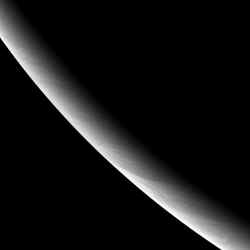
The southwest limb of Saturn. Image credit: NASA/JPL/SSI Click to enlarge
This brooding portrait shows the southwest limb (edge) of the cold gas giant and the thread-like cloud features lurking there. The limb appears smooth, but at the terminator (the boundary between light and dark) and at higher resolution, variations in cloud height can cause shadows that are visible to Cassini (see Such Great Heights).
The image was taken in visible, red light with the Cassini spacecraft wide-angle camera on Oct. 30, 2005, at a distance of approximately 401,000 kilometers (249,000 miles) from Saturn and at a Sun-Saturn-spacecraft, or phase, angle of 155 degrees. Image scale is 20 kilometers (13 miles) per pixel. The image was contrast enhanced to improve visibility of features in the atmosphere.
The Cassini-Huygens mission is a cooperative project of NASA, the European Space Agency and the Italian Space Agency. The Jet Propulsion Laboratory, a division of the California Institute of Technology in Pasadena, manages the mission for NASA’s Science Mission Directorate, Washington, D.C. The Cassini orbiter and its two onboard cameras were designed, developed and assembled at JPL. The imaging operations center is based at the Space Science Institute in Boulder, Colo.
For more information about the Cassini-Huygens mission visit http://saturn.jpl.nasa.gov . The Cassini imaging team homepage is at http://ciclops.org .
Original Source: NASA/JPL/SSI News Release
Galaxies Colliding All Around Us
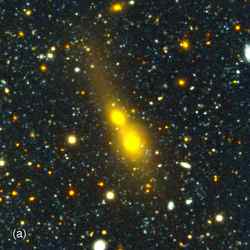
Newly found galaxy collisions in the nearby universe. Image credit: NOAO. Click to enlarge
More than half of the largest galaxies in the nearby universe have collided and merged with another galaxy in the past two billion years, according to a new study using hundreds of images from two of the deepest sky surveys ever conducted.
The idea of large galaxies being assembled primarily by mergers rather than evolving by themselves in isolation has grown to dominate cosmological thinking. However, a troubling inconsistency within this general theory has been that the most massive galaxies appear to be the oldest, leaving minimal time since the Big Bang for the mergers to have occurred.
?Our study found these common massive galaxies do form by mergers. It is just that the mergers happen quickly, and the features that reveal the mergers are very faint and therefore difficult to detect,? says Pieter van Dokkum of Yale University, lead author of the paper in the December 2005 issue of the Astronomical Journal.
The paper uses two recent deep surveys done with the National Science Foundation?s 4-meter telescopes at Kitt Peak National Observatory and Cerro Tololo Inter-American Observatory, known as the NOAO Deep Wide-Field Survey and the Multiwavelength Survey by Yale/Chile. Together, these surveys covered an area of the sky 50 times larger than the size of the full Moon.
?We needed data that are very deep over a very wide area to provide statistically meaningful evidence,? van Dokkum explains. ?As happens so often in science, fresh observations helped inform new conclusions.?
Van Dokkum used images from the two surveys to look for telltale tidal features around 126 nearby red galaxies, a color selection biased to select the most massive galaxies in the local universe. These faint tidal features turn out to be quite common, with 53 percent of the galaxies showing tails, broad fans of stars trailing behind them or other obvious asymmetries.
?This implies that there is a galaxy that has endured a major collision and subsequent merger event for every single other ?normal? undisturbed field galaxy,? van Dokkum notes. ?Remarkably, the collisions that precede the mergers are still ongoing in many cases. This allows us to study galaxies before, during, and after the collisions.?
Though there are not many direct star-to-star encounters in this merger process, such galaxy collisions can have profound effects on star formation rates and the shape of the resulting galaxy.
These mergers do not resemble the spectacular mergers of blue spiral galaxies that are featured in several popular Hubble Space Telescope images. But these red galaxy mergers appear to be much more common. Their ubiquity represents a direct confirmation of predictions by the most common models for the formation of large-scale structure in the Universe, with the added benefit of helping solve the apparent-age problem.
?In the past, people equated stellar age with the age of the galaxy,? van Dokkum explains. ?We have found that, though their stars are generally old, the galaxies that result from these mergers are relatively young.?
It is not yet understood why the merging process does not lead to enhanced star formation in the colliding galaxies. It may be that massive black holes in the centers of the galaxies provide the energy to heat or expel the gas that needs to be able to cool in order to form new stars. Ongoing detailed study of the newly found mergers will provide better insight into the roles that black holes play in the formation and evolution of galaxies.
A series of images of different galaxies in this study that, taken together, represent a time sequence of a typical red galaxy merger, is available here. More information, including an animation of the mergers, is available from Yale University.
Based in Tucson, AZ, the National Optical Astronomy Observatory (NOAO) consists of Kitt Peak National Observatory near Tucson, AZ, Cerro Tololo Inter-American Observatory near La Serena, Chile, and the NOAO Gemini Science Center. NOAO is operated by the Association of Universities for Research in Astronomy (AURA) Inc., under a cooperative agreement with the National Science Foundation.
Original Source: NOAO News Release
